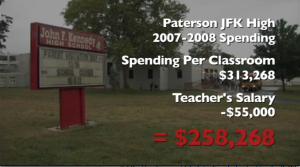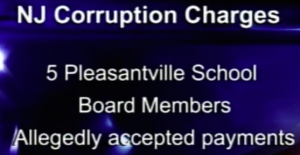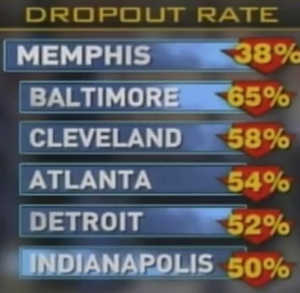The documentary, The Cartel, by director Bob Bowdon covers the quality of American education, primary focusing on the public schooling in New Jersey. One of the main arguments that Bowdon brings up is how can New Jersey have the highest spending level per-student in the country, yet its students fail to perform well in school.
On average 37% of high school students can’t read at the 8th grade level and 90% of those with a high school diploma failed an 8thgrade math test.

The problem is that the state is putting money into the schools, but where is it all going? Throughout the film parents as well as teachers are interviewed and all can agree that the school system is corrupt, where the staff on the school board are much more satisfied with their own salaries rather than student performance.
According to former teacher Beverly Jones, “The children are not the focus. Money is the focus and what happened to the money, no one knows because the money does not reach the classroom”[1]. At JKF high school in Patterson, per classroom, it costs roughly $313,000. Minus the teacher salary is nearly $55,000 there is about $250,000 that goes elsewhere[2].

Bowdon points out that in this corrupt system, the administration in Newark doesn’t deserve such a high pay because the schools aren’t reaching the level where students can actually learn. It’s ridiculous that in a high school classroom of about 20 people, half of them cannot read or cannot do simple elementary school math. For the parents, whom do they blame for their children not getting the proper education that they need to be successful? Is it the teachers? Or the state? In my opinion it is both. In 2007 Shabazz High School spent $30million on a new athletic complex, but 1 out of every 7 seniors at the school tested lower than proficient in math. In the Abbot school district ¼ of the budgets were wasted, leaving schools with little money for reconstruction sites. In one case $1billion just disappeared and no one had an answer to why. The teachers union is also a problem. Bowdon brought up the point that bad teachers rarely get fired. In an example that probably shocked many viewers was the teacher who actually hit students. One would think that he would get fired immediately, but it took 2 years to get him out. Also, there was teacher in California who taught 17 years while being unable to read and write. According to Hector Bonilla, a principal who was fired for reporting a teacher watching inappropriate videos says,“[these teachers unions] play dirty because it is so much money involved”[3]. Another parent claims that the system, “has been pimping their children for a very long time”[4]. Still the New Jersey Schools Development Authority credits its schools for having the highest graduation rate, yet the drop out rate increases each year.

A solution for these problems are to get students into schools where the teachers are willing to explain work, rather than just handing it to the children carelessly – if they do it fine, if they don’t, fine. In magnet and charter schools students are performing much better than they did in previous schools and are actually enjoying what they are learning. One student mentioned that in his old school, there were fights everyday. Since he had transferred schools he is learning in an environment where the teachers care and he has gained a feeling of safety.
The motive of this film is to ultimately open the eyes of the taxpayers, policy makers, and reformers to show that not just schools in New Jersey, but also schools around the country are ruining the lives of children. Because of money, children’s dreams of having that great job in future are getting cut shorter each day. The viewers are able to see the joyous expressions on those who get accepted into better schools, whereas those who don’t get their lottery number called are left to suffer in failing schools.

Still there are critics who just don’t buy in to Bob Bowdon’s reasoning. Children Left Behind, a New York Times article by Jeannette Catsoulis, bashes the film stating, “[Bowdon] employs an exposé-style narration lousy with ad hominems and emotional coercion. Visually horrid and intellectually unsatisfying, “The Cartel” demonstrates only that its maker has even more to learn about assembling a film than about constructing an argument”[5].
Although the director does not do such a good job on the editing process, he excels in conveying the message that our schools are corrupt. Reviewers call the film a revelation as it portrays drastic numbers like only 35% percent of American seniors being proficient in reading and 25% in math. Bowdon points out that the most money is going to the worst schools that are considered “dropout factories”.

With overpaid administrators and bad teachers the nation’s school board has to do a better job in finding a way where students can enjoy, learn, and feel safe a school all the time regardless he geographic location.
[1] The Cartel, directed by Bob Bowdon, (2009; Moving Picture Institute), 0:24:40.
[2] The Cartel, 0:07:13.
[3] The Cartel, 0:46:10.
[4] The Cartel, 0:58:32.
[5] Jeannette Catsoulis, “Children Left Behind”, New York Times, April, 15, 2010, accessed February 23, 2013, http://movies.nytimes.com/2010/04/16/movies/16cartel.html
Alex, excellent analysis on The Cartel. Although I’ve never watched the documentary myself, you provided enough information in order for me to understand the director’s intended message. It’s interesting to see how the Cartel chose to focus on schools located in New Jersey, considering it is one of the wealthiest states in the nation. I guess by doing that, Bowdon is bringing to light the great disparities that exist within the educational system. I noted that you suggested hiring better teachers as a solution to the problem, but is that very realistic?
Also, to add to my comment…Guggenheim (the director of Waiting for Superman) does answer my question through his series of interviews with Washington D.C. Superintendent Michelle Rhee. Although most parents and teachers/school staff “hate” her for firing so many teachers, her proposed plan of raising pay to attract better staff actually worked. You should check the movie out.
This film is similar to the one that I viewed, “Waiting for ‘Superman'” because they both discuss possible reasons why public schools are failing. The director of my film also felt that poor teachers was a main reason that some public schools were unsuccessful. The problems with teacher’s unions were discussed in my film as well, and it was suggested that if more bad teachers were fired, students would learn more and perform better. However, my film did not talk so much about the money aspect of public schools, and it was interesting for me to read about the uncertainty about where taxpayer’s money is actually going, and if it is actually helping students learn.
I enjoyed reading your essay, Alex!
Caroline
This video analysis clarifies the director’s message and identifies some pivotal scenes that effectively communicate it to viewers. Good details on how financial figures are worked into the film. But the NYT reviewer’s criticism is simply quoted. A stronger essay would have evaluated the strength or limitations of the critic’s assessment of the film.